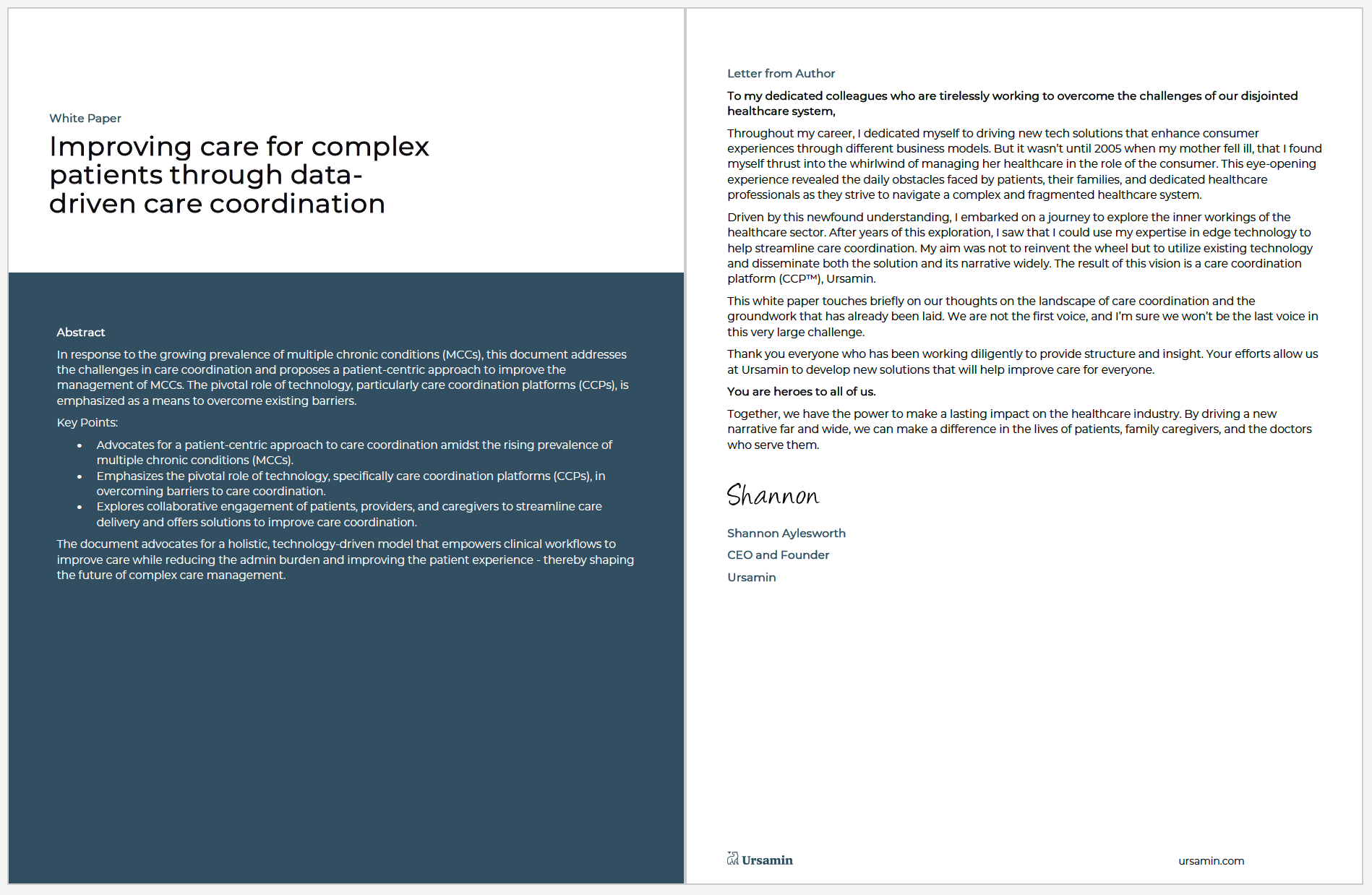
According to research in the U.S. market, the number of people with three or more chronic conditions is projected to reach 83.4 million by 2030. This significant increase highlights the urgency of developing effective care management approaches.
Polychronic conditions, also known as multiple chronic conditions (MCCs), such as diabetes, cardiovascular disease, and cancer are the leading causes of death and disability in the U.S. Understanding the unique challenges in managing these conditions is crucial to improving patient outcomes and reducing healthcare costs.
Challenges in Managing Polychronic Conditions
Managing polychronic conditions presents several challenges for healthcare providers. According to a study conducted by the University of Chicago, primary care physicians would need more than 24 hours a day to provide recommended care to their patients. In fact, the study found that “If they followed national recommendation guidelines for preventative care, chronic disease care, and acute care, it would take a primary care physician 26.7 hours per day to see an average number of patients”. This puts a heavy workload on the doctors who are trying to provide the best possible care outside of the emergency room.
Polychronic patients often experience longer hospital stays, higher readmission rates, and lower patient satisfaction compared to individuals with single chronic conditions. These problems are not limited to the hospital setting; they extend to emergency rooms, where the influx of unmanaged polychronic patients leads to overcrowding and overwhelmed staff.
High healthcare spending associated with patients having multiple chronic conditions puts stress on patients but also on the healthcare system. This further emphasizes the need for effective chronic care management strategies.
According to a study published by the Agency for Healthcare Research and Quality (AHRQ), titled “Implementation of an Electronic Care Plan for People with Multiple Chronic Conditions,” significant findings were observed regarding patient-reported data and its impact on tracking and improving patient health over time.
For instance, let’s consider a patient with diabetes, hypertension, and arthritis. Each condition requires specific medications, lifestyle modifications, and monitoring. This patient sees a primary care physician, an endocrinologist, and a rheumatologist for her different conditions. Coordinating care among these specialists can be challenging, with each provider having different treatment plans and recommendations. This lack of coordination can result in medication errors, conflicting advice, and gaps in communication. As a result, the patient may struggle to adhere to their treatment plans, leading to suboptimal control of their conditions and potentially worsening health outcomes.
As a result, the patient may struggle to adhere to their treatment plans, leading to suboptimal control of their conditions and potentially worsening health outcomes. By integrating patient-reported data and actively involving caregivers, they can provide coordinated and integrated care that improves patient outcomes and enhances patient satisfaction.
What is Meant by A Holistic Approach to Managing Polychronic Conditions
To address these challenges, healthcare providers need to adopt a more holistic approach and develop comprehensive care plans that consider the individual’s unique needs and circumstances, as emphasized in the AHRQ study. And, most importantly, healthcare providers should seek out solutions that will connect patients seamlessly from their outpatient clinic to their inpatient clinic.
A holistic approach to managing polychronic conditions is essential for providing optimal care. It involves considering the patient as a whole, and considering their physical, mental, and social well-being. Each aspect of a patient’s life can impact their overall health and should be addressed in the management of polychronic conditions.
Lifestyle choices and behaviors play a significant role in the development and progression of polychronic conditions. Factors such as diet, physical activity, smoking, and alcohol consumption can influence the course of chronic diseases. For example, individuals who engage in regular physical activity and follow a healthy diet are more likely to have better control of their conditions and experience improved health outcomes.
To illustrate the importance of a holistic approach, let’s consider another patient example, a patient who has diabetes, heart disease, and depression. In addition to prescribing medications and recommending lifestyle modifications for their physical conditions, healthcare providers would also assess and address the patient’s mental health. They may refer this patient to a mental health specialist for therapy or prescribe medication for his depression. They may also consider their social determinants of health, such as access to healthcare resources.
Unified Systems and Platforms for Managing Polychronic Conditions
But how do patients, healthcare providers, and care teams effectively account for medical, lifestyle, and general information inclusively? Today, the lack of accessible and unified health record systems for everyone involved in the patient’s care journey – including providers, caregivers, care teams, and the patients themselves – poses significant challenges in managing polychronic conditions effectively. Fragmented and disconnected health records create obstacles to data flow, coordination, and communication among each stakeholder. Incorporating new data sources such as patient-reported outcomes, patient behavior, wearable data, and other information occurring outside the traditional EMR is becoming even more critical than ever to managing chronic illnesses, so the medical community can determine better where to intervene and prevent unnecessary visits to the ER.
Platform solutions, such as Ursamin, exist to alleviate these challenges by streamlining care, integrating fragmented systems, and facilitating seamless communication across everyone involved in the patient care pathway.
Here are some reasons why it’s critical to achieve a unified system:
- Empowers Comprehensive Care
A unified health record system enhances treatment plan adherence, reduces data fragmentation, and empowers healthcare providers to make informed decisions based on comprehensive patient data. With access to a patient’s complete medical history, healthcare providers can better understand their conditions, previous treatments, and medication history. This information promotes better coordination of care and reduces the risk of medication errors or duplicate tests.
- Patient-Centric Approaches and Benefits
Implementing a unified health record system benefits patients in managing their own polychronic conditions. With access to their complete medical history consolidated within Ursamin’s platform, patients can easily share their information with healthcare providers, reducing the need for repetitive tests and procedures. They can also play a more active role in their healthcare journey by reviewing their records, understanding their conditions, and participating in shared decision-making with their healthcare providers. A unified health record system empowers patients to be more engaged in their care and enhances their overall healthcare experience.
- Combats Chronic Care Challenges
Significant challenges exist for providers, patients, and caregivers due to fragmented care, insufficient coordination, and inadequate electronic health record systems. Using a single, unified platform that enables data flow across each stakeholder will:
- Reduce Administrative Burden: Administrative tasks and patient privacy plans are consolidated to reduce duplication and speed up completion, making data retrieval and information sharing easier.
- Improve Coordination of Care: By facilitating extended care team integration, and collaboration platforms with the right features and ensure better communication and coordination among providers, patients, and caregivers.
- Empower Patient Adherence: Using a single platform for patient nudging techniques, education, notifications, and information access, helps patients stay engaged and adhere to their treatment plans.
- Increase Revenue Outcomes: When providers can streamline chronic care and service billing into a single platform, this maximizes revenue while offering improved care quality.
Impact of Polychronic Conditions on Healthcare Costs
The complexity of treating polychronic conditions can result in longer hospital stays and higher readmission rates. Polychronic patients may require multiple medications, specialized treatments, and frequent monitoring, which can prolong their hospitalization. The impact of these conditions has a ripple effect – across the healthcare landscape, ER utilization, disease progression, and inpatient care coordination.
By addressing the complexities of multiple chronic conditions, healthcare providers can deliver a smooth transition from inpatient to outpatient care. This level of coordinated care is essential for preventing complications, avoiding hospital readmissions, and providing consistent patient care.
Consider a patient who has diabetes, heart disease, and kidney disease, this patient’s condition requires regular check-ups, medication management, and lifestyle modifications. Due to the complexity of conditions, without early intervention and proper management, this patient can easily experience multiple hospital admissions and longer hospital stays.
Each hospitalization incurs additional costs for tests, procedures, and specialized care. These are cumulative costs that significantly impact healthcare spending. However, proactive management slows the progression of these diseases, reducing the need for more expensive treatments such as dialysis or amputations.
Coordinating care throughout a patient’s journey improves healthcare outcomes, cuts costs, and enhances the patient experience.
Final Thoughts On Managing Polychronic Conditions
Around 50% of the US population has a chronic disease, creating a significant challenge for healthcare providers and the entire healthcare system. This surge in cases emphasizes the urgency of developing effective management strategies to enable better patient outcomes while reducing the substantial healthcare costs associated with complex chronic conditions.
Traditional healthcare approaches, primarily focused on acute disease management, have fallen short in addressing the needs of patients with multiple chronic conditions. This misalignment has contributed to inadequate access to care, lower care quality, and skyrocketing healthcare expenditures.
Effective strategies for managing polychronic conditions involve adopting holistic care approaches, embracing unified systems/platforms, and leveraging data and approaches that foster collaboration among all stakeholders. These methods not only improve patient outcomes but also enhance treatment plan adherence, ultimately reducing healthcare costs.
For those interested in more insights into the prevalence of polychronic conditions and overcoming emerging challenges, we invite you to listen to our Unlimited Access podcast episode: https://youtu.be/8T0mSJddFqE.





